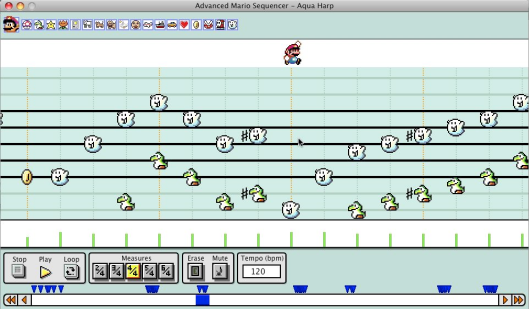A few days ago we tried snapping the wii tokens to a 100x100 pixel grid. It gives it a very different feel. Emily's comment was that she wanted to play with a triangular/hex grid.

This prompted me to think that maybe what you want is to be able to "pull out a piece of graph paper" (and there are different types of graph paper). That is, you pull out a backdrop that provides an organizing principle for the activity in the foreground. The board that you place tokens on.
You could also pull out boards that enable dynamic behavior. For example, the Game of Life board could be an extension of the graph paper board that implements a grid-based cellular automata. Or the music staff board could let you arrange tokens as notes and hear them.

(e.g. Mario Paint)
As Dave points out, editing music/video is often just about arranging rectangles on a timeline.
----------
Towards the Hypercard-like environment: a big objective with this is experiencing what it would be like to make software together (not the "1.5 player" mode of pair programming).
One thing we could try is putting screens and keyboards on the desk. Then you point at a token or board on the screen with your wiimote and pull up the "script editor" for that object on your screen, where you can change its behavior.
For example, the current noun project wall has three object classes: the moveable icons, the "template" icons that appear in the search results (which are like normal icons except they duplicate when you move them), and the search results area itself (which in addition to the text box has the behavior that when you drop an icon on it, the icon gets deleted).
So one would point at any of these things and see the scripts that drive that behavior and also that specify their visual appearance (e.g. the React render method).
I think this would at least bring the "making of" experience into the system itself.
I'm not sure if individual screens/keyboards is the right physical architecture for this. It's vital that the big projection is primary and the script editor screen is secondary. My hope would be that, say, Nagle and I could discuss some behavior we wanted to try and say "okay, I'll make the tokens behave like this and you make the music staff behave like this", quickly make some small changes to the scripts in parallel, and then meet back up on the big screen.